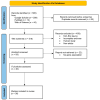A Comprehensive Systematic Review Coupled with an Interacting Network Analysis Identified Candidate Genes and Biological Pathways Related to Bovine Temperament
- PMID: 39202342
- PMCID: PMC11354074
- DOI: 10.3390/genes15080981
A Comprehensive Systematic Review Coupled with an Interacting Network Analysis Identified Candidate Genes and Biological Pathways Related to Bovine Temperament
Abstract
Comprehension of the genetic basis of temperament has been improved by recent advances in the identification of genes and genetic variants. However, due to the complexity of the temperament traits, the elucidation of the genetic architecture of temperament is incomplete. A systematic review was performed following the Preferred Reporting Items for Systematic Reviews and Meta-Analyses (PRISMA) statement to analyze candidate genes related to bovine temperament, using bovine as the population, SNPs and genes as the exposure, and temperament test as the outcome, as principal search terms for population, exposure, and outcome (PEO) categories to define the scope of the search. The search results allowed the selection of 36 articles after removing duplicates and filtering by relevance. One hundred-two candidate genes associated with temperament traits were identified. The genes were further analyzed to construct an interaction network using the STRING database, resulting in 113 nodes and 346 interactions and the identification of 31 new candidate genes for temperament. Notably, the main genes identified were SST and members of the Kelch family. The candidate genes displayed interactions with pathways associated with different functions such as AMPA receptors, hormones, neuronal maintenance, protein signaling, neuronal regulation, serotonin synthesis, splicing, and ubiquitination activities. These new findings demonstrate the complexity of interconnected biological processes that regulate behavior and stress response in mammals. This insight now enables our targeted analysis of these newly identified temperament candidate genes in bovines.
Keywords: Kelch family genes; SST; behavior; cattle; splicing; temperament pathways; ubiquitination.
Conflict of interest statement
The authors declare no conflicts of interest.
Figures








Similar articles
-
Association of SNPs in dopamine and serotonin pathway genes and their interacting genes with temperament traits in Charolais cows.J Appl Genet. 2017 Aug;58(3):363-371. doi: 10.1007/s13353-016-0383-0. Epub 2016 Dec 16. J Appl Genet. 2017. PMID: 27987181
-
Novel genes involved in the genetic architecture of temperament in Brahman cattle.PLoS One. 2020 Aug 21;15(8):e0237825. doi: 10.1371/journal.pone.0237825. eCollection 2020. PLoS One. 2020. PMID: 32822435 Free PMC article.
-
Using imputed whole-genome sequence variants to uncover candidate mutations and genes affecting milking speed and temperament in Holstein cattle.J Dairy Sci. 2020 Nov;103(11):10383-10398. doi: 10.3168/jds.2020-18897. Epub 2020 Sep 18. J Dairy Sci. 2020. PMID: 32952011
-
Underlying genetic architecture of resistance to mastitis in dairy cattle: A systematic review and gene prioritization analysis of genome-wide association studies.J Dairy Sci. 2023 Jan;106(1):323-351. doi: 10.3168/jds.2022-21923. Epub 2022 Nov 1. J Dairy Sci. 2023. PMID: 36333139
-
Unveiling the Genetic Landscape of Feed Efficiency in Holstein Dairy Cows: Insights into Heritability, Genetic Markers, and Pathways via Meta-Analysis.J Anim Sci. 2024 Jan 3;102:skae040. doi: 10.1093/jas/skae040. J Anim Sci. 2024. PMID: 38354297 Free PMC article.
Cited by
-
The genomic comparison between autochthonous and cosmopolitan cows reveals structural variants involved in environmental adaptation.Sci Rep. 2025 Jul 1;15(1):22280. doi: 10.1038/s41598-025-07165-5. Sci Rep. 2025. PMID: 40593057 Free PMC article.
-
Editorial for the Special Issue "Advances in Cattle, Sheep, and Goats Molecular Genetics and Breeding".Genes (Basel). 2025 Jul 16;16(7):826. doi: 10.3390/genes16070826. Genes (Basel). 2025. PMID: 40725482 Free PMC article.
References
-
- Hernandez A., Galina C.S., Geffroy M., Jung J., Westin R., Berg C. Cattle welfare aspects of production systems in the tropics. Anim. Prod. Sci. 2022;62:1203–1218. doi: 10.1071/AN21230. - DOI
-
- Friedrich J., Brand B., Schwerin M. Genetics of cattle temperament and its impact on livestock production and breeding—A review. Arch. Anim. Breed. 2015;58:13–21. doi: 10.5194/aab-58-13-2015. - DOI
Publication types
MeSH terms
LinkOut - more resources
Full Text Sources

